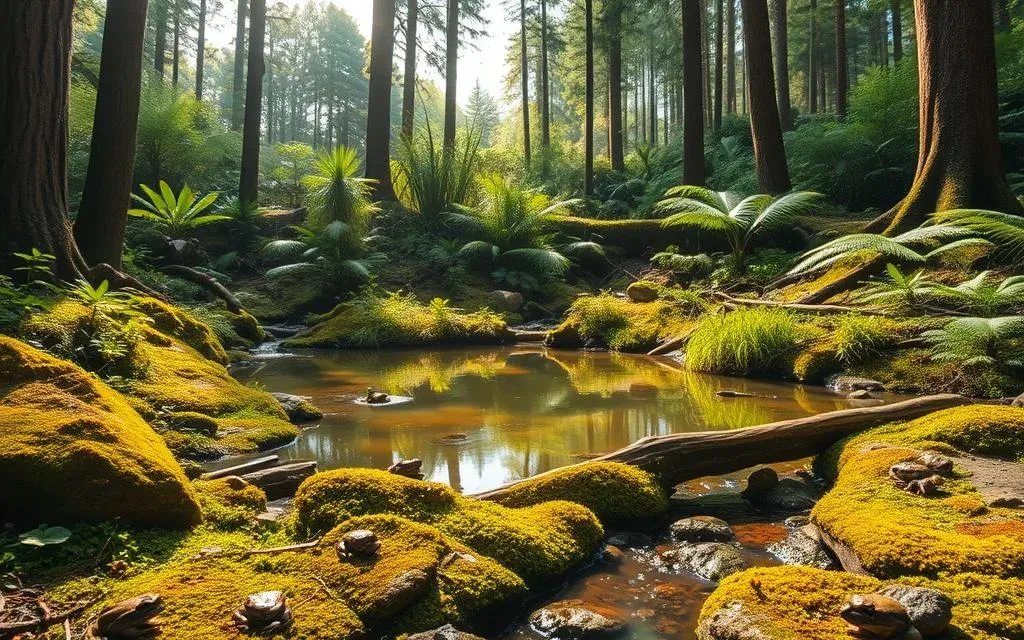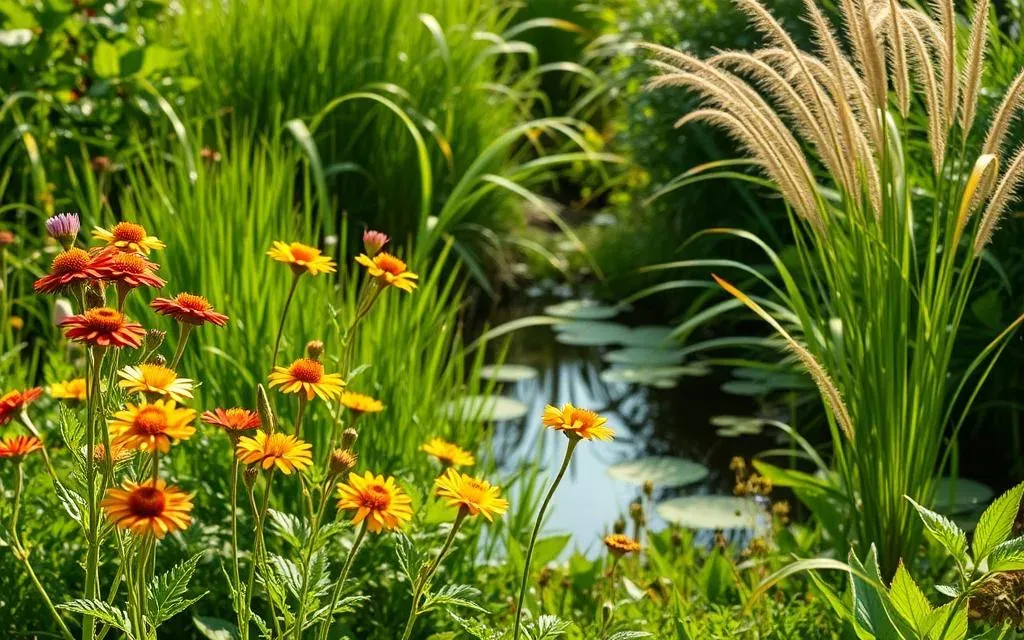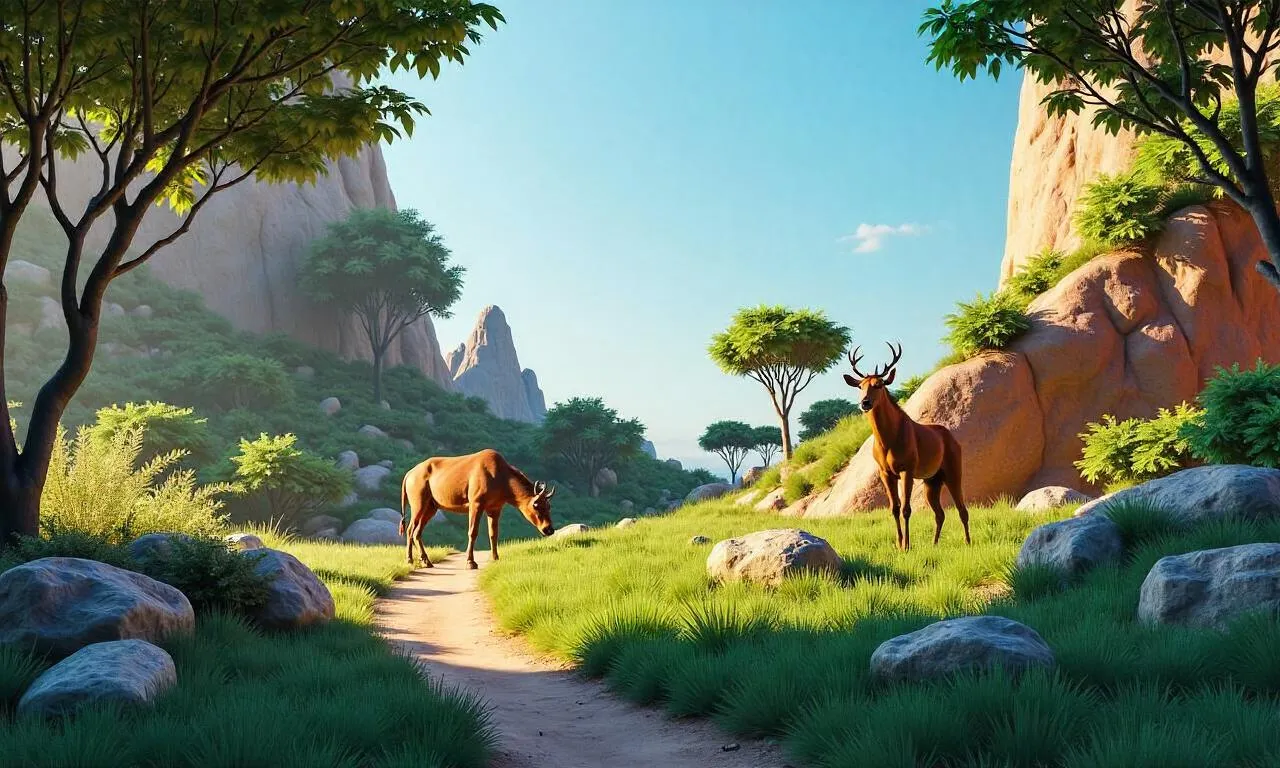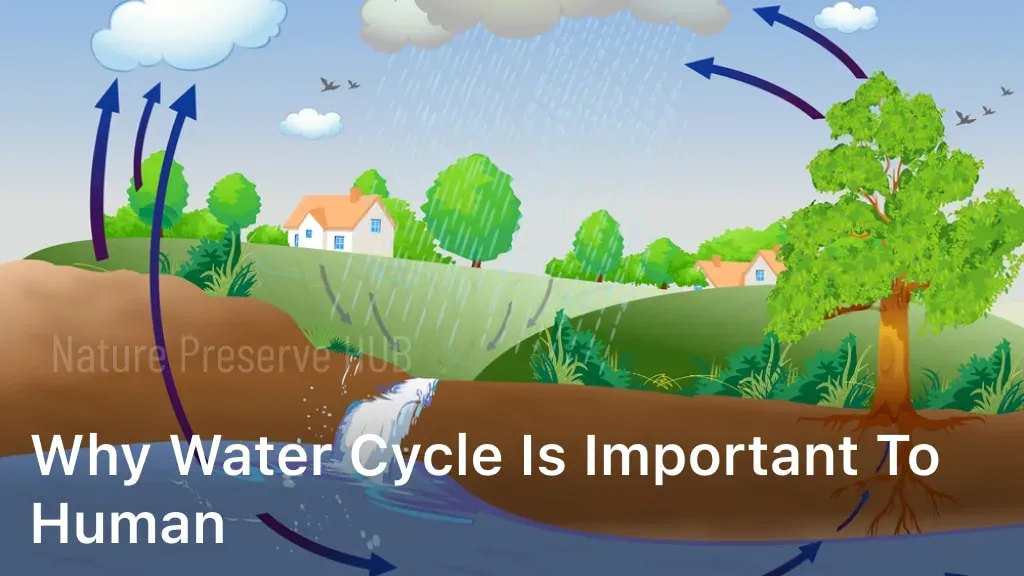Did you know that your backyard could become a sanctuary for frogs? These tiny amphibians play a vital role in maintaining a balanced ecosystem. By providing them with a welcoming space, you can boost biodiversity and naturally reduce insect populations.
We transformed our garden into a haven for frogs, and the results were incredible. Watching them thrive in a chemical-free environment was rewarding. It’s amazing how small changes can make a big difference for wildlife.
In this article, we’ll share practical tips to help you design a frog-friendly space. From adding water features to using recycled materials, these DIY ideas are simple and eco-friendly. Let’s work together to create a habitat where frogs can flourish.
Table of Contents
ToggleIntroduction to a Frog-Friendly Environment
A frog-friendly garden not only supports biodiversity but also brings nature closer to home. By repurposing your outdoor space, you can create a thriving ecosystem that benefits both wildlife and your surroundings.
One of the most rewarding aspects of this transformation is the joy it brings. Watching frogs thrive in a natural setting is a reminder of how interconnected our world is. Even small changes, like adding a water feature or planting native trees, can make a big difference.
Choosing the right place for these elements is crucial. Frogs need access to clean water and shelter to feel safe. By incorporating these features, you’ll also attract beneficial insects and birds, creating a balanced environment.
Here’s a quick look at the benefits of a frog-friendly garden:
| Benefit | Description |
|---|---|
| Enhanced Pollination | Frogs and insects help pollinate plants, boosting garden health. |
| Natural Pest Control | Frogs reduce insect populations, minimizing the need for pesticides. |
| Increased Biodiversity | A variety of wildlife, from birds to insects, will visit your garden. |
By making these changes, you’re not just creating a safe place for frogs. You’re also contributing to a healthier, more vibrant ecosystem right in your backyard.
Understanding Frog Biology and Needs
Frogs are fascinating creatures with unique behaviors and specific habitat needs. By understanding their biology, we can create spaces where they feel safe and thrive. This knowledge helps us design environments that support their natural habits.
Frog Behavior and Habitat Preferences
Frogs are attracted to areas with clean water and ample shelter. They prefer places with a mix of ground cover and plants, which provide hiding spots from predators. Seasonal activities, like breeding, also influence their habitat choices.
Water quality is crucial for frogs. They seek out ponds or wetlands with the right depth and temperature. Adding native plants around these water features enhances their appeal, creating a balanced ecosystem.
Benefits of Incorporating Amphibians in Our Garden
Having frogs in your garden offers numerous advantages. They act as natural pest controllers, feeding on insects like mosquitoes and flies. This reduces the need for harmful chemicals, promoting a healthier environment.
Frogs also contribute to biodiversity. Their presence attracts other wildlife, such as birds and beneficial insects. By creating a frog-friendly space, we support a thriving, interconnected ecosystem right in our backyard.
How to Create a Safe Habitat for Frogs
Designing a frog-friendly area requires thoughtful planning and eco-conscious choices. By focusing on key elements, we can ensure the space is both safe and inviting for these amphibians. Let’s explore the essential steps to make your outdoor area a thriving habitat.

Key Considerations for a Frog-Friendly Space
Choosing the right place is the first step. Frogs need a balanced environment with access to clean water, shelter, and food. Avoid using chemicals in the area, as they can harm both frogs and their food sources, like insects.
Water management is crucial. A well-designed pond with a secure liner provides a safe spot for frogs to breed and thrive. Adding native plants around the pond enhances the habitat, offering shade and shelter.
Expert Tips for a Sustainable Habitat
Using recycled materials is a great way to support sustainability. Items like old bricks or logs can create secure entry points and hiding spots. These small details, often referred to as “that thing,” can significantly improve the space for both frogs and toads.
Proper hardware cloth over water features ensures safe access while preventing accidents. This simple addition makes the area more accessible for amphibians while keeping them protected.
By focusing on these key considerations and expert tips, we can create a harmonious habitat that supports local wildlife. Every small effort contributes to a healthier ecosystem in our own backyard.
Building Your Frog Pond and Wetland Features
Building a pond in your backyard is a rewarding way to attract frogs and other beneficial creatures. It’s a simple project that can transform your outdoor space into a thriving ecosystem. By using recycled materials and natural elements, you can create a sustainable and inviting wetland feature.
DIY Pond Construction with Recycled Materials
One of the easiest ways to build a pond is by repurposing items like old kiddie pools or recycled pots. These materials are cost-effective and eco-friendly. Start by digging a shallow area in your yard and placing the pool or pot securely.
Next, install a pond liner to prevent water leakage. Layer the bottom with gravel and rocks to create diverse water zones. This setup ensures frogs have safe entry and exit points. Adding subtle slopes around the edges makes it easier for them to navigate.
Incorporating Natural Elements and Rock Features
Natural rocks add texture and provide shelter for frogs, toads, and insects. Use locally sourced river rocks to blend the pond seamlessly into your landscape. Arrange them in clusters to create hiding spots and enhance the overall appearance.
Multiple water depths are essential for a healthy wetland feature. Shallow areas are ideal for breeding, while deeper sections offer refuge during extreme weather. This balance supports a variety of wildlife, making your pond a vibrant part of the ecosystem.
- Use recycled materials like kiddie pools or pots for the base.
- Install a pond liner and layer gravel for stability.
- Add natural rocks for shelter and aesthetic appeal.
- Create varying water depths to support different species.
By following these steps, you can build a pond that attracts frogs and enhances your outdoor space. It’s a simple yet impactful way to support local wildlife and create a natural retreat.
Creating Safe Entry and Exit for Frogs
Ensuring frogs can safely enter and exit their water features is essential for their survival. A well-designed pond includes pathways that allow these amphibians to move in and out effortlessly. By focusing on accessibility, we can create a space where frogs thrive without unnecessary risks.
Designing Accessible Frog Entry Points
Low entry points are crucial for frogs to access water features safely. Using materials like ceramic roof tiles or non-slip surfaces ensures secure “leap ways” for these creatures. These elements should be placed strategically around the pond’s edge to provide easy access.
Natural rocks can also enhance accessibility. Arrange them in clusters to create gradual slopes, allowing frogs to navigate without difficulty. This setup not only supports their movement but also blends seamlessly into the landscape.
Implementing Protective Measures for Water Features
Protective measures are vital to safeguard frogs and prevent accidents. Hardware cloth placed over the pond’s liner and side ensures safe access while keeping young visitors secure. This simple addition makes the area more accessible for amphibians.
Using durable and eco-friendly materials is key. Recycled items like old bricks or logs can create entry points that are both functional and sustainable. These modifications ensure the space remains safe and inviting for all wildlife.
| Design Element | Purpose |
|---|---|
| Ceramic Roof Tiles | Provide secure entry and exit points |
| Hardware Cloth | Prevent accidents and ensure safety |
| Natural Rocks | Create gradual slopes for easy navigation |
| Recycled Materials | Enhance sustainability and functionality |
By assessing the area and making thoughtful modifications, we can ensure frogs move safely in and out of their water features. These small changes contribute to a thriving, frog-friendly environment.
Integrating Native Plants and Water Sources
Native plants and clean water are essential for a thriving frog habitat. These elements provide food, shelter, and breeding grounds, creating a balanced ecosystem. By carefully selecting the right plants and maintaining water quality, we can support both frogs and beneficial insects.

Selecting Frog-Friendly Native Plants
Choosing native plants is a key step in designing a frog-friendly space. These plants are adapted to local conditions, making them low-maintenance and ideal for supporting wildlife. Species like milkweed, ferns, and sedges provide cover and attract insects, which are a primary food source for frogs.
Grouping plants around the pond’s edge enhances the habitat. This setup offers shade and shelter, creating a safe environment for amphibians. It also supports pollinators, contributing to a healthier ecosystem.
Maintaining a Healthy, Chemical-Free Water Feature
Clean water is vital for frogs and other aquatic life. Avoid using chemicals in or around the pond, as they can harm amphibians and their food sources. Regularly flushing and conditioning the water ensures it remains safe and inviting.
A secure pond liner is essential for maintaining water quality. It prevents leaks and protects the surrounding soil. Adding rocks and gravel to the pond’s side creates natural filtration, supporting a balanced aquatic environment.
By integrating native plants and maintaining chemical-free water, we create a sustainable habitat for frogs. These efforts not only benefit amphibians but also enhance the overall health of our outdoor spaces.
Enhancing Your Landscape for Wildlife
Transforming your outdoor space into a wildlife haven is easier than you think. By making thoughtful landscaping choices, we can attract beneficial insects, support pollinators, and create a thriving ecosystem. These efforts not only benefit frogs but also enhance the overall health of your garden.
Attracting Beneficial Insects and Supporting Pollinators
Reducing chemical use is a key step in attracting beneficial insects. Pesticides can harm both frogs and their food sources, like insects. Instead, opt for natural pest control methods to create a safer environment.
Preserving natural ground cover is another effective strategy. Leaves, logs, and native plants provide shelter for insects and amphibians. These elements also support pollinators, like butterflies, which play a vital role in maintaining biodiversity.
Cultivating a Biodiverse Garden Environment
Strategically placing water features near tree clusters can enhance your garden’s appeal. Trees offer roosting sites and pathways for wildlife, while water features provide essential hydration and breeding grounds for frogs.
Incorporating natural elements, like a well-planned liner and designated pathways, creates clear corridors for wildlife movement. These small changes make your garden more accessible and inviting for a variety of species.
| Strategy | Benefit |
|---|---|
| Reduce Chemical Use | Protects frogs and their food sources |
| Preserve Ground Cover | Provides shelter for insects and amphibians |
| Place Water Features Near Trees | Supports wildlife hydration and movement |
| Use Natural Elements | Creates clear pathways for wildlife |
By implementing these strategies, we can cultivate a biodiverse garden that supports frogs, insects, and other wildlife. These efforts contribute to a healthier, more vibrant ecosystem right in our backyard.
Incorporating Frog Hotels and Additional Shelter Options
Frog hotels are a creative and practical way to support amphibian populations. These structures provide essential shelter, especially for tree frogs and toads, complementing the larger habitat in your garden. By using simple materials like PVC pipes and recycled items, we can create safe spaces for these creatures to thrive.
DIY Frog Hotel Construction Using PVC and Recycled Materials
Building a frog hotel is an easy and eco-friendly project. Start by gathering materials like PVC pipes, ceramic bowls, and gravel. Cut the pipes into varying lengths to create multiple chambers. Secure the components with gravel and decorative rocks for stability and aesthetic appeal.
Place the hotel near a pond or water feature to attract frogs and toads. Ensure the structure is shaded and protected from predators. Adding native plants around the hotel enhances its appeal and provides additional cover for amphibians.
Optimizing Shelter for Tree Frogs and Other Amphibians
Frog hotels offer a secure retreat for tree frogs and other amphibians. These shelters mitigate predator risks and provide a safe space for breeding and resting. Positioning the hotel in a shaded area with access to water ensures it remains functional and inviting.
Even small elements, like a pot or rock, can contribute to the overall habitat quality. These additions create diverse microhabitats, supporting a variety of species. By incorporating these shelters, we enhance the biodiversity of our outdoor spaces.
| Material | Purpose |
|---|---|
| PVC Pipes | Create multiple chambers for shelter |
| Ceramic Bowls | Provide secure entry and exit points |
| Gravel | Stabilize the structure and enhance drainage |
| Decorative Rocks | Add aesthetic appeal and additional shelter |
By constructing frog hotels and optimizing shelter options, we create a welcoming environment for amphibians. These efforts not only support local wildlife but also contribute to a healthier, more vibrant ecosystem.
Conclusion
Supporting local wildlife starts with simple, thoughtful changes in our outdoor spaces. By creating chemical-free habitats, we provide a safe place for frogs, toads, and other species to thrive. DIY projects like building ponds and shelters can transform any garden into a haven for these creatures.
Every small step matters. Ensuring clean water, adding native plants, and incorporating diverse shelter options can significantly impact frog populations. These efforts not only benefit amphibians but also enhance biodiversity in our communities.
Let’s continue exploring innovative ways to support wildlife. Together, we can create lasting, eco-friendly spaces that foster a healthier ecosystem for frogs, butterflies, and beyond.
FAQ
What makes a garden frog-friendly?
A frog-friendly garden includes native plants, a clean water source like a pond, and shelter options such as rocks or logs. Avoid chemicals to keep the environment safe for amphibians.
Why are native plants important for frogs?
Native plants provide natural food sources and shelter for frogs. They also attract insects, which are a primary food source for many amphibian species.
How do we build a DIY frog pond?
Use a pond liner or recycled materials to create a shallow water feature. Add rocks, plants, and gradual slopes to ensure frogs can enter and exit safely.
What are the benefits of having frogs in our garden?
Frogs help control insect populations, including pests. They also contribute to a balanced ecosystem and indicate a healthy environment.
How can we protect frogs from predators?
Provide hiding spots like dense plants, rocks, or frog hotels. Ensure the pond has shallow edges and avoid introducing fish that may prey on tadpoles.
What types of water features attract frogs?
Shallow ponds, wetlands, or even container water gardens with clean, chemical-free water are ideal. Adding native aquatic plants enhances the habitat.
How do we maintain a chemical-free garden for frogs?
Avoid pesticides and herbicides. Use organic gardening methods and natural pest control to keep the environment safe for amphibians.
What materials can we use to build a frog hotel?
Use PVC pipes, terracotta pots, or recycled materials to create shelters. Place them in shaded, moist areas near water sources.
How do we attract beneficial insects for frogs?
Plant flowers like milkweed, coneflowers, and goldenrod to attract pollinators. These insects serve as food for frogs and support biodiversity.
What should we consider when designing a frog habitat?
Focus on water quality, shelter, and food sources. Ensure the area has shade, moisture, and minimal disturbance to create a thriving environment.
















